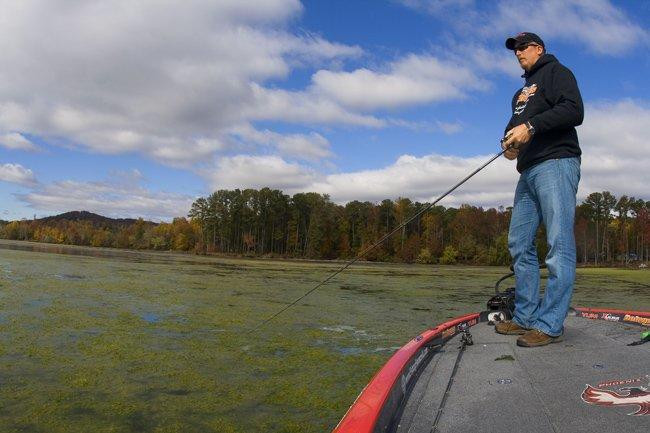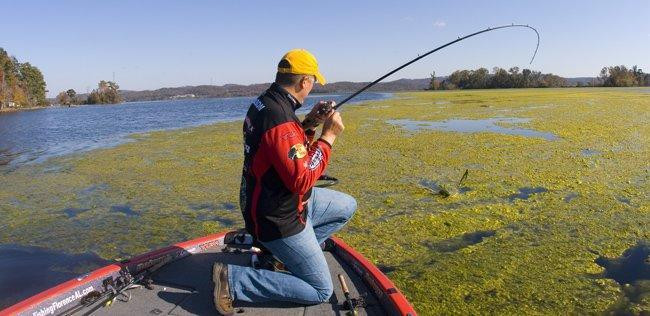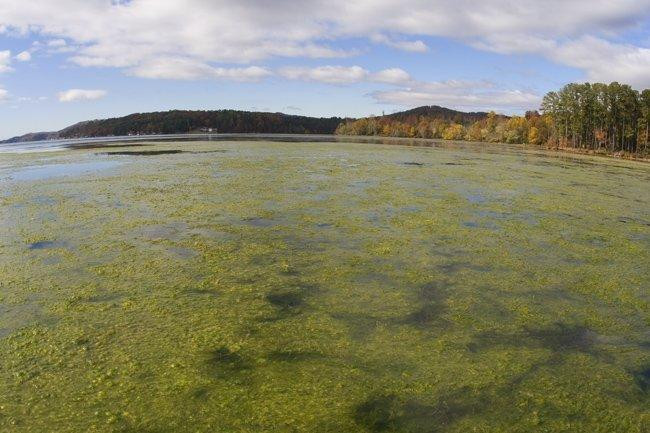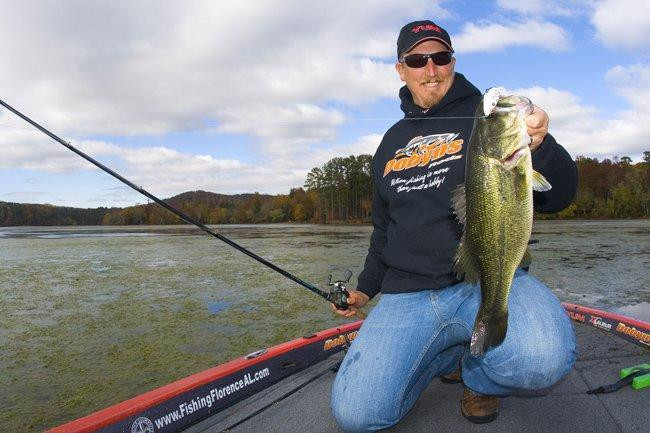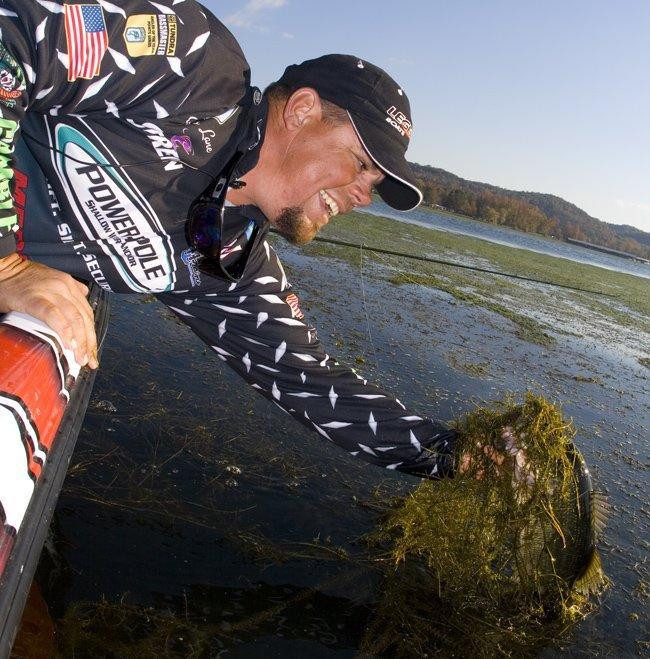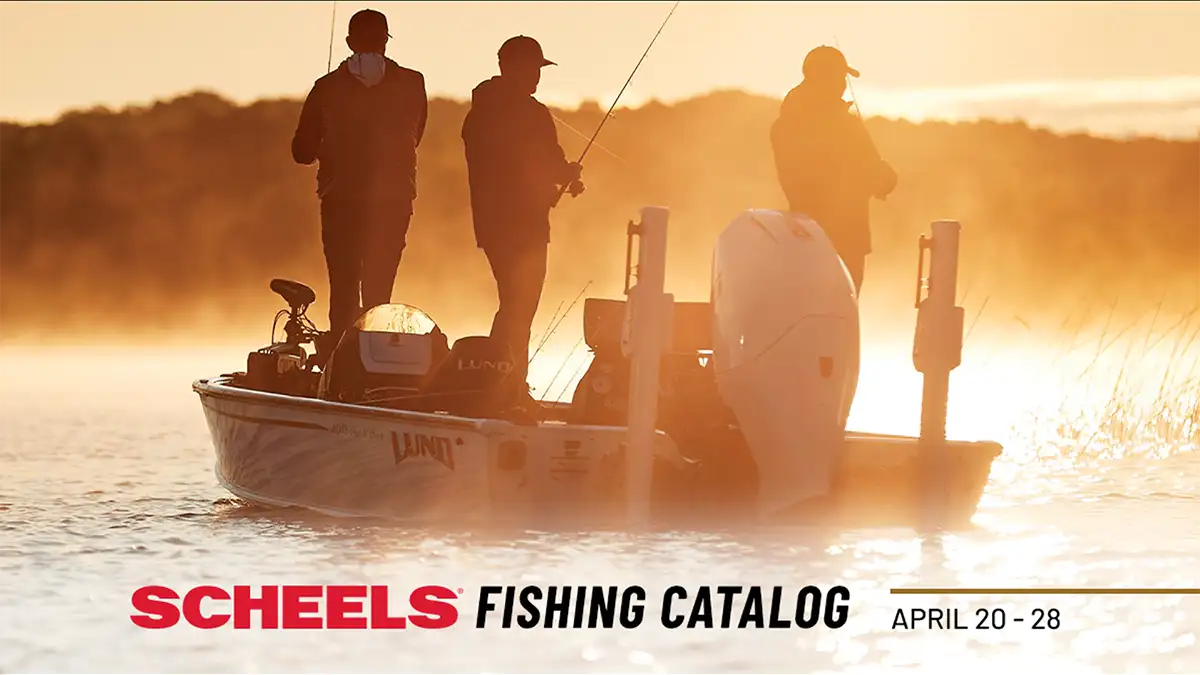There are certain types of bass fishing that really turn you inside out as an angler. One of those techniques is frogging in grass mats. Turning inside out is not always a good thing. Frogging can be the most exhilarating and breathtaking way to catch bass. And frogging can also be the most frustrating situation anglers can experience in bass fishing.
To limit the frustrations and maximize those magical moments, we tapped two expert froggers and got some nitty gritty tips on what separates the most productive mats from the seemingly endless supply of matted grass on certain fisheries.
Bassmaster Elite Series pro Chris Lane is originally from Florida but now makes his residence in Guntersville, Ala. He has spent nearly his whole life fishing, much of it around matted grass with hollow-bodied frogs. Jimmy Mason is a former Elite Series pro now professional guide on Alabama lakes like Guntersville, Neely Henry and more. Both have spent thousands of hours with a frog in hand figuring out the puzzle. Their knowledge can really help shortcut your fishing.
Mason idled out through a by covered in matted vegetation. “There’s the cheese I’ve been looking for,” he said. “These mats look really good here.”
Don’t worry if you don’t know what a cheesy mat looks like. Heck I had no idea what he was talking about either at first. But basically Mason was referring to a bubbling of moss, thick weed and clean grasses that creates an almost foamy flexible layer on the surface of the water that supports a frog well but is easy enough for a bass to nose up through and slurp down something. It’s the combination of dying grass and still fresh grass that makes the map seem to be molding like some old cheese. When the mats are “cheesy” they are getting right.
The matted vegetation needs to have an almost dry consistency for the frog to walk and slap over the top of it as you fish it. It will give you a more effective racetrack for ripping your frogs over the top of it and for some reason the bass really gravitate towards those types of mats more than others.
“Sometimes a mat can be too wet,” Lane said. “I don’t like it when the frog just slides through it. I want it hooking and grabbing and popping on the mat. Sometimes when you have some rain or fog and condensation, like a cool morning in the fall, the bite might not be good until the afternoon when the mat has had time to dry up.”
Mason often looks for what’s under and around the mat to pinpoint exactly where he’ll start the probing for bass hiding underneath. He’ll also use his ears to listen for “Rice Krispies.”
Often a ditch, creek channel nearby, a long point or hump can make an ordinary mat a lot better. And he often finds some of his best mats in the prespawn period before he ever sees the grass.
“Those spots that are really good lipless crankbait spots in the in early spring can turn into some of the best matted frog spots in the fall,” Mason said.
That’s because the structure and surrounding contours make the location prime. The matted vegetation cover just gives the bass a security blanket to make them feel safe and comfortable enough to “raid the fridge” so to speak in the comfort of their own house.
Once you find the right looking structure under or near the grass mats, the next thing is to pull in and start fishing and just listen. The mats will sound like they are popping, creaking and clicking. That sound is small baitfish, bluegill and other aquatic vertebrates stewing and feeding on the underside of the mats. That clicking sound sounds like Rice Krispies in a bowl of cold milk and will get the bass in the mats looking up.
There are other little nuances about reading a mat of grass that can tell you frog fishing is going to be good there. One of those tell-tale signs is a blow hole.
“I’m constantly looking for blow holes,” Lane said. “I want to see where bass have been coming up and busting through the mat to either get at other frog lures or real prey.”
As Lane coasted down through the mat he pointed out holes all in the mat where he felt bass had popped through. These holes were about the size of a small coffee can. There were some holes that had a similar sized path out to open water where a bass had likely blown up on a frog and been hauled out by an angler.
There were little small trails through the grass mats and occasional openings in the mats. These edges seemed to really draw the bass into predictable places within productive mats. That’s the key to fishing like vegetation. Find small nuances that give you more specific isolated targets within the sea of cover.
Once finding active fish, it was just a matter of getting them to react to the frogs. Both anglers are fond of the Snag Proof Frogs. Lane in fact designed the new Snag Proof Guntersville Frog just for matted grass fishing. The legs are small molded plastic wings that house an oversized rattle in each foot. The rattles give the rear of the frog a little more weight and Lane likes the way it keeps the frog popping and scooting on the mats.
Mason has been throwing Snagproof Frogs for a long time and often experiments with the smaller frogs when the bite gets tough. But he’s also become pretty fond of the new Yum Pad Crasher frog and has had a lot of fun playing with that new frog this fall. It features very lifelike profiles and standard rubber legs that match the lifelike finishes of the frogs.
Both anglers experiment with their retrieves but like a fast cadence to start. Lane worked his Guntersville Frog with a nonstop pitter patter cadenced across the mat with tiny little slaps on the mat to move the frog an inch or less at a time.
However there are days where the bass demand a slow methodical pop on the mat, stopping occasionally when a fish boils or rolls under the mat. Often if you will just stop the frog nearby and quiver it in place, the bass will circle back and come suck it down.
Fishing hollow-bodied frogs like this means heavy rods, heavy braid and strong reels with good brakes and wrenched down tight drag. A little tip action can make you a more accurate caster, but you want to get the frog in the bass’s mouth and the bass back into your boat and that requires a lot of back bone, trolling motor off-roading and some digging and excavation work at times to get the bass out of the mats.
Frog fishing can be extremely rewarding. Often there are small windows where it’s best, and you’ve got to capitalize on when the mats are in prime condition and the bass are underneath them. Don’t skimp on the line or your frog choices. Spro, Strike King, LiveTarget and others all make great frogs now and there is a color for every type of water out there now.
Don’t miss your windows for some exciting bass fishing in heavy matted grass. The strikes are exhilarating, the bass are often large and the fights monumental.



